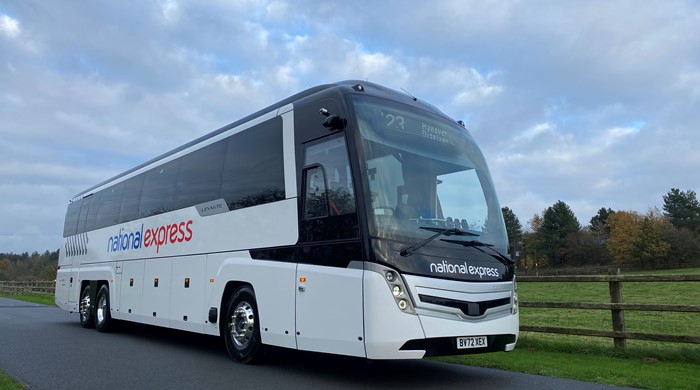National Express trial innovative mirrorless coaches
23 November 2022 12:00 PM

The new Caetano Levante IIIA on trial with National Express
National Express is trialling the latest innovation in safety, set to hit roads across the UK in the coming months.
The all-new Caetano Levante IIIA is the first in the coach company’s white fleet to use Orlaco’s ‘Mirroreye’ system - a state-of-the-art camera monitoring system (CMS) which replaces the use of conventional wing mirrors.
Developed in partnership with the Portuguese manufacturer, the CMS will help improve visibility around the coach, remove blindspots, give improved night vision and reduce the risk of minor collisions. The removal of wing mirrors will also help improve fuel efficiency, thanks to the slick aerodynamic design.
Other new features of the Levante IIIA are e-driver alerts, drawing drivers' attention to potential hazards such as vulnerable road users or obstructions within the blindspot area. The cab design has also improved, enabling drivers to easily navigate controls such as heating/air-conditioning and wheelchair lift deployment.
The updated chassis on the Scania Step E model has potential to upgrade to future zero-emission vehicles, supporting National Express’ commitment to operating a net zero fleet by 2035.
Over the coming months, the coach operator will have two Levante IIIA vehicles on trial, working with partner operators Clarkes of London and Bruce’s Coaches to run a range of short, medium and long-distance routes.
Tom Linnecor, head of engineering at National Express, said: “The new Levante IIIA represents a step forward in the vehicle’s design. It takes driver technology to the next level by increasing the number of safety features and keeping our passengers and other road users front of mind.
“Working closely with Caetano, the majority of the latest changes implemented have stemmed from feedback from our drivers and engineers. In addition to improved visibility for drivers, the mirrorless coaches will also deliver significant fuel savings. We’re looking forward to getting the Levante IIIA out on the road and gaining as much insight as we can.”
As part of the trial, National Express will review driver feedback and make any necessary specification changes before the vehicles are then rolled out across the fleet from Spring 2023, in line with the company’s continual replacement programme.
Key Facts - Caetano Levante IIIA with Scania ‘Step E’ Chassis
The current Levante III is built upon the Scania Step D chassis. This will now be replaced by their Step E variant which will support potential future zero-emission vehicles. The Step E variant is very similar, but has a number of changes, in particular a new front-end module and suspension. It brings a number of additional features as standard, and the option to add extra features, which overall will increase the safety of the vehicle.
Key Facts: Axles: 3 (Tri); Height: 3.9m; Width: 2.55m; Length: 14.3m; Weight: 16,600 Kgs; Luggage Hold: 10.3m3; Seating: 54 or 53 + 1 Wheelchair; Engine: 13 Litre 410hp; Gearbox: 12 Speed Opticruise
Camera Monitoring System (CMS)
There are two internal monitors, a 15” mounted to the near side ‘A’ pillar, and a 12’’ mounted on the drivers side. There are two external cameras mounted in the area where the usual mirror brackets would be located. Both monitors contain an ambient light sensor which adjusts the brightness depending on the environment. Also available soon is a third camera known as the ‘kerbside’ view. This camera will enable a direct view of the front of the vehicle.
Blind Spot Warning
The blind spot warning is a function that alerts the driver if a vehicle is positioned in the blind spot. This system is designed to reduce the risk of accidents caused by a lack of visibility in this area. The approaching vehicles are detected via radar sensors that are fitted on each side of the vehicle, located directly behind the front wheels.


